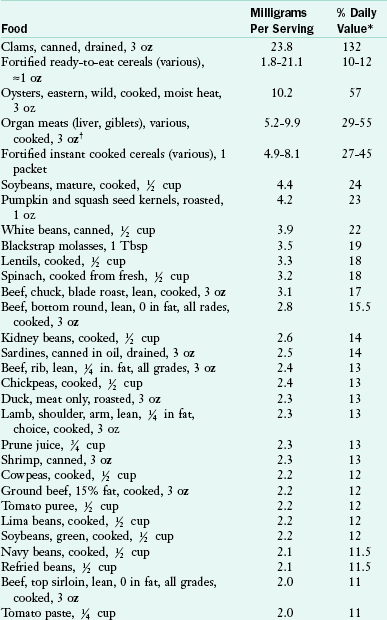Nutritional Facts on Iron
Iron is a nutrient found in trace amounts in every cell of the body. Iron is part of hemoglobin in red blood cells and myoglobin in muscles. The role of both of these molecules is to carry oxygen. Iron also makes up part of many proteins and enzymes in the body. Iron deficiency anemia is common in children, adolescent girls, and women of childbearing age. It is usually treated with an iron-rich diet as well as iron supplements. Iron exists in foods in two forms: heme iron and nonheme iron. Vitamin C enhances the absorption of nonheme iron and should be consumed at the same time as an iron-rich food or meal. Substances that decrease the absorption of nonheme iron are:
Oxalic acid, found in raw spinach and chocolate
Phytic acid, found in wheat bran and beans (legumes)
Heme iron is absorbed more efficiently than nonheme iron. Heme iron enhances the absorption of nonheme iron. The richest dietary sources of iron are from:
Iron from nonheme sources (as in vegetables, fruits, grains, and supplements) is harder for the body to absorb. These sources include:

*Daily values (DVs) are reference numbers based on the recommended dietary allowance. They were developed to help consumers determine if a food contains a lot or a little of a specific nutrient. The DV for iron is 18 mg. The %DV listed on the Nutrition Facts panel of food labels states the percentage of the DV provided in one serving.
†High in cholesterol.
Tips For Increasing Iron Intake
The amount of iron the body absorbs varies, depending on several factors. For example, the body will absorb more iron from foods when iron stores are low and will absorb less when stores are sufficient. In addition, certain dietary factors affect absorption. Combine heme and nonheme sources of iron. Eat foods rich in vitamin C with nonheme iron sources:
Drink coffee or tea between meals rather than with a meal.
Cook acidic foods in cast iron pots, which can increase iron content up to 30 times.
What About Too Much Iron?
It is unlikely that a person would take iron at toxic (too high) levels. However, children can sometimes develop iron toxicity by eating iron supplements, mistaking them for candy. Symptoms include the following: fatigue, anorexia, dizziness, nausea, vomiting, headache, weight loss, shortness of breath, and grayish color to the skin.
Hemochromatosis is a genetic disorder that affects the regulation of iron absorption. Treatment consists of a low-iron diet, no iron supplements, and phlebotomy (blood removal) on a regular basis.
Excess storage of iron in the body is known as hemosiderosis. The high iron stores come from eating excessive iron supplements or from receiving frequent blood transfusions, not from increased iron intake in the diet.
To reduce the iron from dietary sources, review the list of foods and exclude or severely limit their intake until the iron overload is alleviated. Pay particular attention to sports drinks, energy bars, and fortified cereals that have significant amounts of added iron.

 cup low-fat or fat-free yogurt
cup low-fat or fat-free yogurt cup cantaloupe
cup cantaloupe cup black refried beans
cup black refried beans cup mashed potatoes
cup mashed potatoes cup fresh steamed green beans topped with almonds
cup fresh steamed green beans topped with almonds cup fresh strawberries
cup fresh strawberries cup mixed nuts
cup mixed nuts